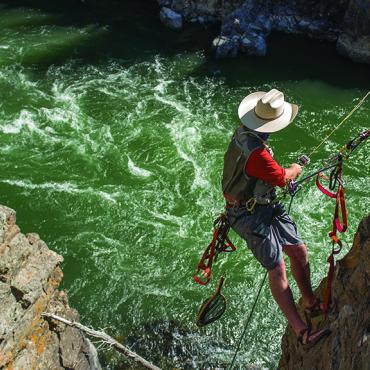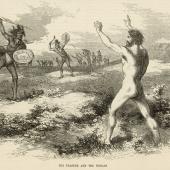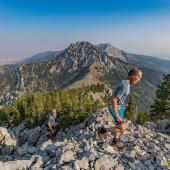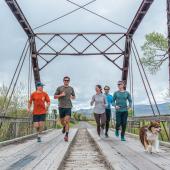If the Shoe Fits
Sky-shoeing takes off.
People have used snowshoes to travel in deep snow for nearly 6,000 years. In that time, snowshoe design has been gradually refined, but their general purpose has remained fairly constant: walk more efficiently through powder snow, from point A to point B. Until now, snowshoes have been somewhat clumsy tools intended for travel across largely flat ground—tools most often used by retirees and urbanites seeking a disappointing winter-hiking experience. But a new generation of young Bozeman snowshoers is pushing the sport—and themselves—to new heights with a radical take on an ancient practice.
Enthusiasts call it Sky-Shoeing (“skootching” for short), and it combines ultra-running with extreme downhill skiing. The concept is simple: run on snowshoes to the top of a mountain, then descend as quickly as possible by the most direct route. While simple in theory, it requires elite fitness and parkour-inspired balance, agility, and confidence. Skootchers are free to choose their preferred path up and down, and there are only two rules: don’t fall, and don’t remove your snowshoes. As such, skootching favors the fittest and boldest—those who take the most direct, and often most dangerous line—and enthusiasts often find themselves sprinting down precipitous slopes, jumping off cliffs, and even throwing tricks in the pursuit of glory.
Pioneering skootcher Brody Postoler invented the sport after consuming a potent kombucha SCOBY inside a dry sauna, where he experienced a vision of running down snowy mountainsides, being chased by fire demons. “It was a spiritual revelation” he explains. “I grew up downhill skiing and Nordic skiing here in Bozeman, but never really identified as a skier, per se. It turns out I was a big-mountain snowshoer all along. And I think a lot of people can relate.”
Finding traditional snowshoes unfit for the kind of antics he envisioned, Postoler developed his own. Constructed with carbon-fiber tubes, Kevlar webbing, titanium cleats, and silicon-impregnated nylon bindings, each sky-shoe weighs less than a pair of Jordans. Virtually every competitive skootcher in the world is using Postoler Shoes, and he does brisk business selling his $1,200 custom creations. “This isn’t a sport where you can cut corners,” he explains. “People’s lives are on the line—off-the-shelf REI snowshoes have no place here.”
Other than custom snowshoes, the gear required for skootching is minimal. Because it’s a high-output aerobic sport, most competitors favor Nordic ski tights for mobility, though some also wear mountain-bike armor for protection. “We’re literally running down cliffs a lot of the time, so crashing is part of the game,” Postoler admits. Avalanches are also a constant concern. “We’ve lost a couple of great skootchers to slides,” he says. “But they died doing what they loved; they believed in this movement and progressing the sport. That’s big-mountain snowshoeing, man.”
So what’s the difference between big-mountain free-skiing and skootching? “Think it’s extreme to make ski turns down a 50-degree slope?” Postoler asks. “Try sprinting down that same slope with no way to slow down, wearing nothing but carbon-fiber snowshoes, spandex leggings, and a fanny pack loaded with Nature Valley granola bars. That’s extreme.”
Will Eustop agrees. Eustop is a locally famous painter and Instagram influencer (his artistic output involves boldly stylized and virtually indecipherable acrylic paintings of mountain scenes, and equally bold and prolific selfies), and perhaps the most accomplished skootcher in the world. Sponsored by Voke Tab, DB’s Moustache Wax, and Dave’s Sushi, Eustop has three world-championship victories to his name, and a dizzying list of first snowshoe descents: Saddle Peak, Sacagawea’s east face, Hellmouth Couloir on Alex Lowe peak, and others. His “cinematic” YouTube videos of slow-motion coffee preparation and snowshoeing heroics have garnered nearly a million views. On his website (WillEustopSkootching.com), he un-ironically describes the sport as, “Pure athleticism, wrapped in daring, marinated in drama, seared on the sizzling griddle of human faith.” His advice for new skootchers? “In skootch, as in life, the trick is just to keep your feet under you. Stay centered; stay upright; stay stoked.”
So where does this young new sport go now? “We’re going to keep growing,” Postoler insists. “The world is craving something authentic, and there’s nothing more authentic than sprinting face-first down snowy mountains. We’re going to convert all these rando-race skiers—talk about a ridiculous sport—and it’s going to take on a whole new dimension, man. It’s going to be huge.”
As for Eustop, well, there are still a lot of mountains to ‘shoe. “I want to be the first to skootch K2,” he says. “I think it goes.” Heli-skootching is also on his radar. “I don’t even know if it’s possible, but Alaska spine-skootching could be rad.” At the end of the day, for skootchers it all comes down to being in the mountains and challenging themselves. “I can’t imagine what I’d be doing if not sky-shoeing,” Eustop says. “Probably just backcountry skiing or something old-school like that.”













